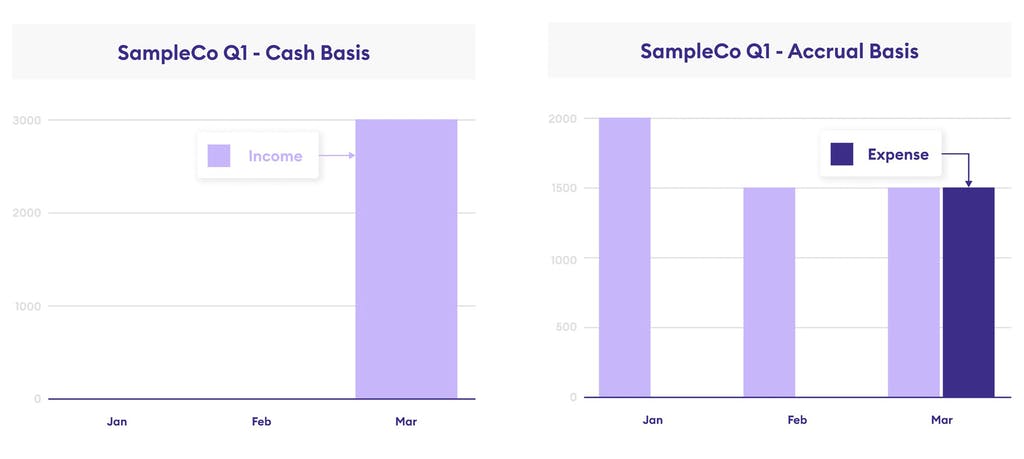Understanding Cash-Basis Accounting vs. Accrual-Basis Accounting
A confirmation email has been sent to your email.

When setting up your business’s accounting structure, you have two methods to choose from: cash-basis accounting, or accrual-basis accounting. This is an important decision to make; the method you choose will determine how your business tracks and reports on its finances.
If you’re new to the finance side of running a business, it can be a confusing decision as well. In this blog, we’ll explain what each method means, the differences between them, and why one usually is a better option for your business.
What is Cash-Basis Accounting?
With the cash-basis accounting method, recording your transactions is straightforward: the transaction is recorded in your books when money changes hands.
For example: Company A closes a deal for $50,000 on June 1, with net-45 payment terms. On July 15, the payment arrives in Company A’s account. Company A’s books will record the revenue on July 15, because that’s when they received the money.
Benefits of Cash-Basis Accounting
Easy to understand your cash flow. Since transactions are only recorded once you either receive or pay out cash, cash-basis accounting makes it simple to understand your business’s cash flow. If it’s in the books, it’s in your bank account.
Easy to track and understand. Because the cash-basis method is so straightforward, it’s often easier to use for business owners without a financial background. Using cash-basis doesn’t require much specialized knowledge of bookkeeping or accounting practices.
Disadvantages of Cash-Basis Accounting
An incomplete view of your finances. Cash-basis accounting makes it simple to track your cash position…and not much else. It won’t tell you how much you’ve made in sales, when you earned the revenue, or what might be coming next.
Can set you up for surprises. The downside of only recording transactions when cash is received or paid out is that your books don’t reflect upcoming expenses – for example, if a large bill will be due in the near future. If you don’t keep a careful eye on your spending commitments, it’s easy to lose track of what will be paid out when (and potentially overspend by mistake).
Besides just potentially missing upcoming expenses, the cash-basis method also doesn’t align your expenses to the period where you actually receive the benefit from the expense. A good example is if your company purchases an annual contract to use a software tool. Under the cash method, this will show up as a single large expense in the month that you pay for it. However, you’re actually getting value for the purchase every month for the following year – which isn’t clear in the cash-basis books.
What is Accrual-Based Accounting?
With the accrual-based accounting method, transactions are recorded in the books as they occur, as revenue is earned, and as expenses are utilized, regardless of when money changes hands. The payment will then be recorded when it arrives or is paid.
Going back to our earlier example, Company A closes a deal for $50,000 on June 1, with net-45 payment terms. Under accrual accounting, on June 1 an entry for $50,000 will be recorded in Company A’s AR records, indicating that the company is now owed this money. When the cash arrives in their account on July 15, the AR records will be updated to show that the invoice has been paid.
Depending on Company A’s business, however, that may not be the end of the story. Another key aspect of accrual-based accounting is revenue recognition: the way a business accounts for its revenue. Revenue is generally recognized when it is “realized or earned,” i.e., when the business provides what the customer has paid for.
If Company A sells physical goods, this may be fairly straightforward: the revenue will be recognized when they fulfill the customer’s order. If Company A sells subscription services, however, things are a bit more complex. The revenue will be considered “realized or earned” when the service is delivered. For a yearly subscription service, this usually means recognizing a certain amount each month.
If Company A’s $50,000 sale was for an annual subscription, each month the company would recognize $4166.67 ($50,000 / 12) in earned revenue (note that we’re using a very simple case to illustrate this – revenue recognition can actually get quite complex, which is why it’s a good idea to get help from a finance professional). After the full year, the complete amount would be recognized as revenue, because Company A would have delivered the complete service that the customer paid for.
Benefits of Accrual-Basis Accounting
Detailed view of your business’s finances. The accrual method offers you a wealth of information on the overall state of your business. Because transactions are recorded so that expenses or revenue are spread out over the period that your business is receiving or providing value, you can get a good sense for how much revenue you’re earning and how much in expenses you actually incur each period. You can also easily see how much your company is owed in outstanding invoices, and any debts that may be coming up.
Easier forecasting. Because the accrual method provides a rich view into what’s going on with your company’s finances (and what’s happened in the past), it’s easier to identify trends, patterns, and areas of concern. This data then allows you to make more informed predictions about where the business may be going in the future, and what you need to do to get there.
Better insight into your assets’ value. When your company makes a purchase, it’s usually recorded as an expense. With accrual accounting, however, you can capitalize asset purchases above a certain amount. What this means is, instead of recording the purchase as just an expense in the period you purchase it, you can record the purchase as an asset that will continue to provide value to the company over its useful life.
For example – a company buys a computer for $4000. Instead of recording it as an expense when they purchase it, the company can capitalize the computer as an asset and depreciate it over the useful life of the computer. The benefit of this is that the books actually show that the company owns the computer and is gaining value from it over time. By contrast, a short-term purchase recorded as an expense is presumed to be quickly used up and no longer providing value (for example, office supplies). This helps you better understand your company’s overall financial health.
Disadvantages of Accrual-Based Accounting
Complexity. The flip side of the detailed information provided by accrual-basis accounting is that tracking it isn’t always straightforward. Correctly using the accrual method of accounting requires learning all the rules, and careful attention to detail when tracking financials. This learning curve can be challenging for business owners without a financial background.
Less straightforward cash position tracking. With the cash-basis method, it’s very simple to understand your inflow and outflow of cash – because that’s all you’re tracking. Understanding your cash flows using the accrual method takes a bit more work, since there are so many other factors included in your books.
3 Reasons Why Accrual Accounting is a Better Choice than Cash
While there are advantages and disadvantages to both methods, for most businesses the accrual method is the better option. Here’s why.
Reason #1: Accrual Accounting Gives You a Fuller Picture of Your Business’s Health
As we touched on earlier, using the accrual accounting method generates significantly more detail about your business activities than using the cash method. This is important, because those additional details about your sales, your expenses, and when they were recognized are what help you understand how well your business is actually doing (this is also called “the matching principle”: aligning revenue with the period in which it’s earned, and expenses with the period in which their benefit is received). With the limited information you get from cash-basis accounting, it’s harder to know if your business is in a healthy position or not.
Let’s look at this example, from our So You’ve Founded a Startup guide:
SampleCo made 10 sales in Q1, for $500 each: 4 sales in January, 3 sales in February, and 3 sales in March. Each sale had net-60 payment terms, and SampleCo received payment in March from 6 customers. Additionally, SampleCo made a software purchase for $1,500 in March. The purchase had net-30 payment terms, and by the end of March SampleCo was still processing the bill.
SampleCo’s Q1 looks very different, depending on whether they use the cash-basis or the accrual-basis accounting method:

Cash-basis accounting shows us how much money went into SampleCo’s bank account in Q1. While this is important information to know, it’s not the whole story. If we just go by the cash-basis chart, we see a large cash deposit in March, but nothing in January or February. We don’t have any insight into how much SampleCo is making in sales or how often sales are made. For all we know, they could have struggled all quarter and then made a single large sale. For a potential investor or lender, there isn’t enough information here to make an informed funding decision.
Accrual-basis accounting, on the other hand, gives us much more information about what’s going on. We can see that SampleCo is making a steady, regular number of sales each month, which implies a degree of stability in their business. We also get a fuller view of Q1 sales. Because not all of SampleCo’s customers had paid by the end of March, the cash chart only reflected 60% of the company’s actual sales numbers. The accrual chart shows us that more money is on the way, even if it’s not in the bank yet.
The accrual-basis chart also shows us that SampleCo made the software purchase in March – we see $1,500 in expenses. Since the money hasn’t actually been paid yet, it’s not shown in the cash-basis chart. This means that, if we’re relying on cash-basis accounting, there’s no way to know from the records that SampleCo is about to spend half the cash it just brought in. With accrual accounting, we see that that expenditure is coming, and we can figure it into SampleCo’s available cash.
Reason #2: Accrual Accounting Helps You Avoid Unpleasant Surprises
Since the accrual method records expenses when they are incurred, you’ll always know what you’re spending, even if you won’t actually pay out the cash for it yet.
With the cash-basis method, problems can arise from the lack of visibility into future expenses. If your company makes a purchase with net-60 terms, you might not pay that bill for up to two months after you sign the deal. Since the money is still in your bank account, the purchase won’t be recorded. If you’re not otherwise diligently tracking your receipts, this opens the door to overestimating your cash position, and accidentally spending money you won’t actually have in two months when the net-60 bill comes due.
With the accrual method, your AP records will clearly show that you have a scheduled outflow of cash in two months to pay the outstanding bill. You’ll be able to easily see what amount of cash you have actually available to spend (and how much you’re expecting to get in the future as your own AR invoices are paid by your customers).
Reason #3: Accrual Accounting is Industry-Standard
Besides just the additional detail and visibility that you get from accrual-based accounting, there’s one more major reason to use accrual instead of cash: it’s what the business world expects, and it’ll be hard to get taken seriously without it.
Sooner or later, you’ll likely need to raise capital for your business. If you’re planning to pursue a fundraising round, investors will want to see your books – and if you have cash-basis books, it won’t fill them with confidence. If you want to secure funds through a business loan, banks may be reluctant (or simply unwilling) to lend to a business without solid accrual-basis books.
Finally, the IRS requires businesses with over $25M in revenue to use the accrual method for their accounting. If you build a highly successful business, then at some point you’ll need to switch anyway. Why not just start things off right?
Deciding on an accounting method for your business is a big decision, and it’s important to get it right. Your accounting method impacts how well you can measure your business’s health, and forecast what’s likely to happen next. Choosing the wrong method can also cause messes you’ll have to clean up later, as your business grows and your needs evolve. Choosing the accrual method from the beginning lets you avoid future heartburn, and set a foundation for successful business growth.
Whichever method you use for your books, you don’t need to manage it yourself. Learn how Pilot’s financial experts can help you stay on top of your bookkeeping, your budgeting and forecasting, and more.


